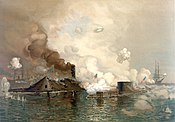Portal:Virginia/Selected article/8
The Battle of Hampton Roads was the most noted and arguably most important naval battle of the American Civil War from the standpoint of naval technology. It was fought over two days, March 8–9, 1862, in Hampton Roads. The battle was a part of the effort of the Confederacy to break the Union blockade, which had cut off Virginia's largest cities from international trade.
On the first day, the Confederate ironclad ram CSS Virginia (built from the remnants of the USS Merrimack), opposed only by conventional, wooden-hulled ships, destroyed two ships and damaged a third. During the night, the USS Monitor arrived. The two ironclads fought for about three hours, with neither being able to inflict significant damage on the other. The duel ended indecisively, the ships did not fight again, and the blockade remained in place.
The major significance of the battle is that it was the first meeting in combat of ironclad warships. It received worldwide attention; Great Britain and France halted further construction of wooden-hulled ships, and others followed suit. The use of a small number of very heavy guns, mounted so that they could fire in all directions, was first demonstrated by Monitor, and soon became standard in warships of all types.

